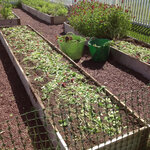Fall cover crops can benefit the home garden
Early fall is the time of year when the air begins to feel a little crisper, the humidity drops and there is a perceptible scent of harvest time in the breeze. Gardeners start thinking about clearing …

You must be a member to read this story.
Join our family of readers for as little as $5 per month and support local, unbiased journalism.
Already a member? Log in to continue. Otherwise, follow the link below to join.
Please log in to continueNeed an account?
|
Fall cover crops can benefit the home garden
Early fall is the time of year when the air begins to feel a little crisper, the humidity drops and there is a perceptible scent of harvest time in the breeze. Gardeners start thinking about clearing out and cleaning up their gardens and closing down for the season. But there is another option to consider — keeping the garden alive through winter with a fall cover crop.
Farmers have long known the benefits of cover cropping their fields and the same methods can be applied on a smaller scale in a home garden. So, what are cover crops, exactly? Also known as “green manure,” cover crops are plants that help to improve and protect your garden’s soil.
Rather than leave the soil exposed through the winter, cover crops can hold it in place, especially in sloped areas, to prevent erosion. The roots of many cover crops (grains like winter rye, barley and oats) help to break up and aerate compacted soil. Plant these between late August and mid-November.
Legumes like crimson clover (my personal favorite) and Austrian field peas improve soil fertility by adding nitrogen through special nodules on their roots that extract this nutrient from the air and convert it to a form that plants can use. These plants will also produce spectacular blooms that not only look nice but attract pollinators. Plant legume cover crops by mid-September to allow them to become established before the first frost.
Cover crops will also help to choke out weeds, and the foliage provides a habitat for beneficial insects and other wildlife. Some, like garden peas, radishes, beans, spinach and kale are cover crops that will also produce food for humans. But best of all, when your cover crops are done with their job, they break down to provide a layer of biomass, or organic matter, on the surface of the soil.
Timing is crucial for the success of a fall cover crop. Started too early, seeds may fail to germinate in hot weather. Started too late, plants may not have time to sprout and become established before the first frost. Check the seed packets for “days to germinate” so that you can plan to get your planting done at the appropriate time.
If you are new to cover cropping and you are undecided as to which crop is right for you, you can purchase a mixture. The advantage of this is that you will be able to see which work best in your garden, and if one type doesn’t grow well for you, your purchase won’t be a total loss.
It’s possible that some of your cover crops will die off, or “winterkill” during the cold months but my experience has been that they survive the winter and are the only green thing I see in my winter garden. If winterkill does not occur, you will need to terminate the cover crops in early spring to prepare the garden for spring planting.
There are a few different ways to handle this. If you need to clear them out quickly, you can choose to simply pull up the cover crops. The disadvantage of this method is that you lose the benefit of adding organic matter to the soil. Another option is to lightly till the cover crop under, chopping up and turning over the green parts to incorporate the plant material into the soil. The disadvantage to tilling is that it can both destroy the soil’s structure and possibly affect the tunnels of hibernating ground-nesting native bees.
My favorite approach is the “chop and drop” method. I cut the plants down to soil level and leave the cuttings on the soil’s surface to decompose into the soil. Other options include smothering the plants with cardboard, tarps or plastic sheeting, or — if you use a legume cover crop — leave a few growing on the edges of the garden or amongst the vegetables to provide a continuous source of nitrogen through the spring growing season.
For more information and a list of fall cover crops for Delaware, a fact sheet is available online on the University of Delaware Cooperative Extension Fact Sheets and Publications section of the web site. Search for the topic “Fall Cover Crops” to access the document.
For questions on this subject or any gardening topic, call the Master Gardener Helpline: In New Castle County, 302-831-8862; in Kent County, 302-730-4000; and in Sussex County, 302-831-3389.
For information about master gardener workshops, visit udel.edu/master-gardeners and click on Garden Workshops.
Members and subscribers make this story possible.
You can help support non-partisan, community journalism.
Other items that may interest you











